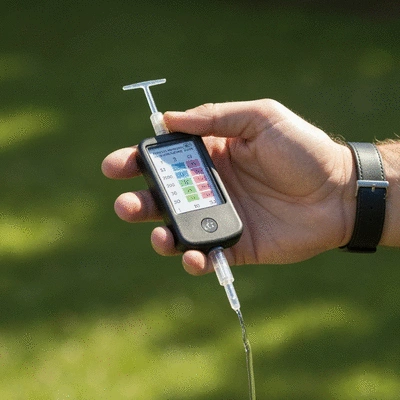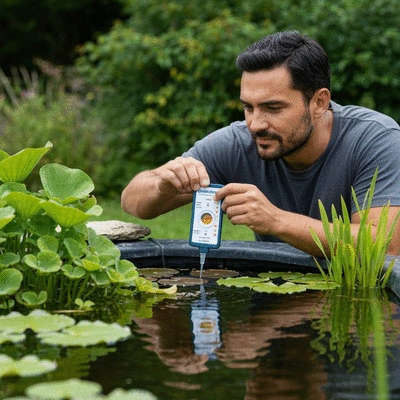
Are you aware that maintaining your pond's health is as critical as caring for your own? Just like our bodies, ponds require regular check-ups to thrive. By understanding and monitoring water quality, you can create a vibrant ecosystem that supports all aquatic life.
Maintaining a healthy pond ecosystem requires regular testing of key water quality parameters. Understanding these measurements helps prevent issues and ensures a thriving aquatic environment.
Indicates acidity or alkalinity. Crucial for fish and plant health. Optimal range supports life.
High levels are highly toxic to fish. Regular monitoring is vital for fish survival.
Essential for fish respiration and overall water health. Low levels lead to stress and death.
(Nitrates, Phosphates) Excess leads to algal blooms and oxygen depletion.
At Clear Pond Solutions, I often emphasize the critical role of water quality testing in maintaining a vibrant pond ecosystem. Without monitoring, your pond could become a breeding ground for problems that jeopardize the health of fish, plants, and other aquatic life. Understanding water quality is the foundational step towards creating a balanced and thriving aquatic environment!
Regular testing allows you to catch issues before they escalate, ensuring that your pond remains a beautiful and healthy feature of your landscape. Are you ready to dive into the essential aspects of water quality that every pond owner should know?
Monitoring water quality is essential for several reasons. First, it helps detect harmful substances that could affect aquatic life, including fish and plants. By keeping an eye on these parameters, you can maintain a balanced ecosystem where all components thrive.

Being proactive is key! By staying informed about your pond's water quality, you are taking essential steps to prevent future problems and maintain a beautiful aquatic space.
There are several critical water quality parameters that every pond owner should test regularly. These parameters provide insights into the overall health of your pond and its inhabitants. The EPA provides national recommended water quality criteria for aquatic life, which can serve as a valuable reference.
Testing these parameters regularly not only ensures a healthy pond but provides you with the knowledge needed for effective management. Remember, knowledge is power when it comes to maintaining your aquatic oasis!
In my experience, nutrient levels in your pond can significantly impact its health and stability. When there are excess nutrients, particularly nitrogen and phosphorus, the result can often be unsightly and harmful algal blooms. These blooms can deplete oxygen levels in the water, leading to dead zones where fish and other aquatic life cannot survive. Monitoring nutrient levels is crucial for preventing these issues. For example, the Texas Water Quality Standards document offers detailed insights into how nutrient concentrations affect aquatic ecosystems.
Here’s why:
So, as you embark on your pond management journey, keep a close eye on those nutrient levels! It's one of the best practices for ensuring the health and happiness of your pond's ecosystem.
Did you know? Consistently testing your pond water not only helps in maintaining fish health but also enhances the aesthetic appeal of your pond. A clear, balanced ecosystem encourages healthy plant growth, which in turn provides natural beauty and habitat for wildlife. Consider setting reminders for regular testing to keep your pond thriving!
Maintaining a healthy pond ecosystem starts with routine water quality checks. Just like we monitor our health, our ponds require the same level of attention. Regular testing not only helps identify potential problems early but also ensures your aquatic environment remains balanced and thriving. Are you ready to dive into the importance of these checks?
By making water quality testing a regular part of your pond care routine, you can significantly enhance the sustainability of your pond. This proactive approach empowers you to address issues before they escalate, helping promote a vibrant aquatic ecosystem. What testing schedule works best for you?
Establishing a consistent testing schedule is key to ensuring your pond remains in top shape. Here are some best practices to consider:
Incorporating these checks not only enhances your pond's health but also minimizes the risk of algal blooms and other water quality issues. Have you thought about how you can integrate regular testing into your routine?

Finding the right testing kit is essential for getting accurate results. Fortunately, there are numerous resources available to help you monitor your pond effectively. Some great places to look include:
When selecting a testing kit, make sure it includes tests for pH, ammonia, nitrite, and dissolved oxygen, as these are crucial for assessing pond health. What resources have you found helpful in your pond management journey?
When it comes to testing pond water quality, you have two primary options: laboratory analysis and field testing methods. Each has its own advantages and disadvantages to consider:
Choosing the right method for your needs depends on your specific pond goals and how often you want to test. Have you explored both options, and which one do you prefer for your pond's health management?
Here is a quick recap of the important points discussed in the article:
At Clear Pond Solutions, we empower you with expert guidance and eco-friendly solutions to create and maintain pristine, healthy pond ecosystems. Your thriving pond is our priority.
